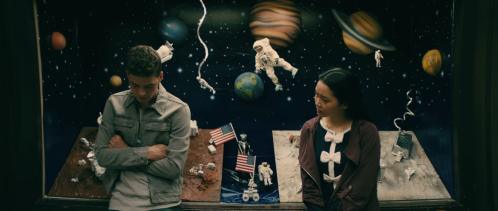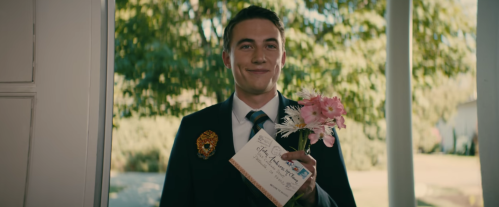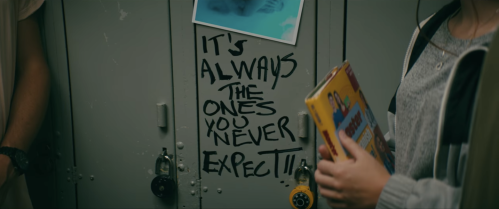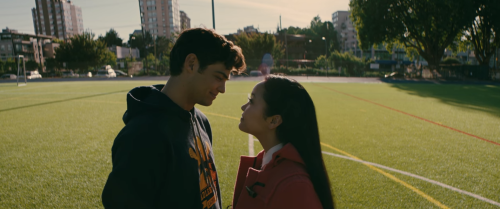
To All The Boys I’ve Loved Before is neither the first nor the last teen romantic comedy launched by Netflix this year: it was preceded by The Kissing Booth, and it will be followed next weekend by Sierra Burgess Is A Loser, with all three films sharing an interest in reclaiming a genre that has been increasingly marginalized by major studios.
But whereas The Kissing Booth is an ideological garbage fire that was rightfully criticized for its wonky gender politics (and, on a personal note, a distinct lack of quality control beyond that), To All The Boys I’ve Loved Before has elevated Netflix’s “Teen Rom-Com Renaissance” while still replicating the “viral” success of The Kissing Booth that signaled the demand for the genre. By the metric of views of “Cast Content” on YouTube—generated by various magazines and websites that pivoted to video in recent years, along with Netflix itself—the story of Lara Jean Song Covey’s letters and her fake relationship with Peter Kavinsky is generating just as much social chatter as its predecessor, but with closer attention to cinematic style and a far less problematic take on teenage romance. The result has been an almost overwhelming response to the film across social media, as Peter Kavinsky (and by extension actor Noah Centineo) became the internet’s boyfriend, and Netflix has the watercooler media that the film’s target demos will carry with them into the school year.
But for any of this to happen, the film itself needs to create moments that fans want to GIF, and a story that leaves them with an emotional reaction that convinces them to take to social media to change their profile pictures, post their edits, and reorient their online existence around this story and the people involved. And that story owes a lot to the Jenny Han book on which the movie is based, and I do think that the film would be generating a significant response even if it would have just taken the story as it was told and brought these characters to life in the capable and charming hands of Centineo and Lana Condor, who doesn’t get enough credit for her work as Lara Jean. But as I discovered when I dove down the To All The Boys I’ve Loved Before rabbit hole over the past two weeks, writer Sofia Alvarez and the film’s producers made a series of conscious choices when adapting the book that engineered the story to maximize this type of response.
They’re also choices that I’d argue make it almost impossible to adapt the rest of the series as it was written.
In the books, which are told in first person, Lara Jean’s fake relationship with Peter is structured as a series of what I’d call “micro-baegressions,” in which Lara Jean—and by extension the audience—gradually sees the layers of their fake relationship peel away to reveal a real connection. And in movie form, those micro-baegressions become the GIF-able moments, the calling cards for those evangelizing Peter Kavinsky and welcoming others to the thirst club.
Now, you may have seen via widely circulated tweets/stories that at least two of these moments—when Peter moves the popcorn to safety before initiating a pillow fight with Kitty during their viewing of Sixteen Candles and when he spins Lara Jean when his hand is in her back pocket—were improvised by Centineo, but they’re all in line with the character as written. However, in adapting the book, Alvarez’s script clears the runway for the audience to fall in love with Peter Kavinsky to a level the book doesn’t, softening the character’s edges and reducing the presence of his romantic rival. The Peter Kavinsky on the screen is more or less the character from the book in terms of his best qualities, but the shift in context and circumstance has allowed the conversation to focus exclusively on the film’s central love story in a way that the book as written wouldn’t allow. This happens in a few key ways.

The Erasure of Josh Sanderson
The biggest component of this is dramatically reducing the role of Josh, and with it erasing anything approaching a love triangle in the film. In the book, Josh is a much more active part of this story, showing up often after his breakup with Margot, and even kissing Lara Jean in the aftermath of the letter. But in the film, Josh largely disappears: there are still key moments where Lara Jean has to negotiate the letter early on, and the climax still depends on Margot’s discovery of Lara Jean’s feelings for Josh, but it feels like Josh only exists to push Lara Jean into and then keep her in her fake relationship with Peter. And the impact of the climax is muted when Lara Jean has already confided in Josh about her fake relationship, an action that further defines Josh as the friend and confidante and never once suggesting in their interaction the possibility of anything else. I could see someone reading the first book in the trilogy and hoping that Lara Jean could still end up with Josh, based on the complexity of their connection, but I find it hard to believe someone could watch the movie and leave with the same sentiment.
Director Susan Johnson has said she herself was surprised how minimal Josh’s role was in the movie when she came onboard, but I’d argue it’s a huge reason why Peter Kavinsky has been an unavoidable presence on social media feeds. By focusing the film entirely on his narrative arc with Lara Jean, there is no division on social media over which side of the love triangle to focus on, and no resentment when the narrative doesn’t play out the way viewers want. By basically removing Josh from the picture, the movie engineers itself into a Peter Kavinsky Internet Boyfriend machine—instead of creating Team Josh and Team Peter, the film never creates a reasonable competition, and thus sows no discord when Lara Jean and Peter acknowledge their real feelings for each other.

The Punchlinification of John Ambrose McClaren
The desire not to give the audience another love interest to root for goes further. In the books, some of Lara Jean’s letters have slightly different origin stories, most specifically in the case of Peter and John Ambrose McClaren. In the movie, John Ambrose is “a boy I did Model UN with in fifth grade,” but in the books John Ambrose was part of the middle school friend group with Lara Jean, Gen, and Peter before moving away pre-high school. He was also the recipient of the spin-the-bottle kiss that in the movie happens with Peter, and he actually appears mid-way through the book: Lara Jean sees that there’s a Model UN event at her school, and presumes John might be there given his past participation, sneaking in and eventually coming face-to-face with her former crush before racing out and then going back to her fake relationship with Peter. It’s a conscious seeding of the sequel, where John Ambrose finally receives the letter sent to his old address, and creates an entirely new love triangle to drive conflict in the second book.
In the movie, though, none of this is true: John Ambrose is not a former mutual friend, and Peter gets his spin-the-bottle kiss instead of the much more complicated book story, in which Peter—not yet in a relationship with Gen but clearly close to one—kisses Lara Jean unexpectedly as they wait for their parents to pick them up after a hangout. John does appear at the end of the movie during the credits scene, but as a punchline, and not as a serious love interest. That choice once again clears the way for the audience to fully embrace Peter Kavinsky, and with due respect to the young Canadian actor they cast as John Ambrose in a wordless performance, he is not instantly hot enough to create any particular interest in what he has to say, which would make the plot of the second book pretty impossible to adapt as it’s written.

The Cannibalization of P.S., I Still Love You
In crafting its happy ending, the film doesn’t just change details of what happens in the first book: it consciously goes beyond it, stealing from the second book in pulling its story together. The book is oriented around seeding the sequel, and actually doesn’t end with Peter and Lara Jean getting together: it ends on Lara Jean’s moment of self-discovery about how she really feels about Peter, but leaves the door open for her to change her mind if the mysterious Model UN boy re-enters the picture. But the film doesn’t leave the door open, rushing forward Peter’s declaration of love that actually concludes the second book, not the first. It’s a choice that doesn’t make sense if you’re planning on making a sequel, but makes perfect sense if you want to create an undeniable romantic moment that leaves the viewer floating as they go to social media, text a friend, or decide to immediately start watching the movie again to see love blossom all over again.
But the film actually does more than move up this key moment: it also introduces and resolves the conflict that drives the entire first half of the second book before the love triangle is introduced. In the books, the sex tape scandal doesn’t happen until the beginning of the second book, and lingers for weeks and months in ways that test Lara Jean and Peter’s still nascent relationship (remember, he hasn’t said “I love you” yet). Peter also spends much of the book denying that Gen was the one responsible for the video, and continues spending time with her, fueling Lara Jean’s paranoia that he still isn’t just trying to use their relationship to get back with her. It’s part of a larger effort to highlight that Peter Kavinsky, while romantic and caring in many ways, is far from perfect.
But in the film, Peter much more quickly accepts that Gen was the one responsible, and Lara Jean’s confrontation with her largely closes the door on her feud with Gen, a confrontation that—like Peter’s declaration of love—doesn’t happen until the end of the second book. The first half of the second book depends on the fallout of the sex tape and Lara Jean’s insecurities about Gen, but the movie mostly closed the book on those developments, and reopening it would require regressing both characters in ways that I can’t imagine viewers responding well to.

To All The Books They’ve Ever Rendered Unadaptable
Put in the simplest terms, the choices that made the adaptation of Jenny Han’s first book so successful on social media are the same ones that have rendered her second book an adaptation minefield. Even if they were to find a way to introduce John Ambrose into the story—he also has a connection to the book’s major new narrative space where Lara Jean works at a retirement community, so it’s not impossible—reopening the love triangle requires the audience to at least slightly turn against Peter Kavinsky, but the movie laid no ground for this. In the books, for example, Peter doesn’t enter into a fake relationship with Lara Jean to get Gen back—he claims he’s doing it to get over her, but that immediately seems like a lie, and fosters distrust. And so while Peter’s desire to get back together with Gen is made blatantly clear in the film, his honesty creates less conflict, and we get to see him fall in love with Lara Jean and out of love with Gen as the film goes on. And even when they do feed into Lara Jean’s paranoia about their connection, like when Gen conspicuously has Lara Jean’s scrunchie, the movie abandons the first-person perspective of the books (it’s the only time they do it outside of cutaways to Kitty and their father) to show us Peter and Gen’s conversation so we know why she has it, and know to trust Peter when he claims nothing is going on with Gen.
The second book, as a narrative, depends on the reader questioning Peter Kavinsky’s motives, something that the film very consciously avoids, and which seems difficult to reconstruct given the version of Peter Kavinsky brought to life onscreen—already those who’ve read the books are warning people how the book turns the reader against Peter, something that I’d argue the first book lays the groundwork for in a way the movie does not. In order to create enough reason for Lara Jean to break up with him or even consider breaking up with him without turning the audience against her character, the writers would need to have Peter directly violate the themes of trust the movie’s climactic scene play into, which could turn the audience against the movie for so swiftly violating the perfect internet boyfriend the first movie constructed. I can see why the producers leaned into the character’s better qualities, and responded to Centineo’s performance and the star power therein, but the resulting characterization is fundamentally at odds with how the reader is meant to feel about that character to be able to imagine him cheating on Lara Jean with Gen or Lara Jean choosing John Ambrose instead.
And yet it’s clear based on the response to the film that there will be a sequel, and if the actors are under contract for multiple films they might just barrel forward and try to adapt the books as they stand. But if I were in charge, I would actually abandon the second book entirely and move forward to the third book, Always and Forever, Lara Jean, because it basically starts off when the movie ends emotionally speaking. It fast-forwards to the spring of Lara Jean and Peter’s senior year, testing their nearly year-long relationship as they make college decisions and face the same crossroads that Margot and Josh did at the start of the first book and movie. Its conflicts are not dependent on anything that is introduced in the second book, really, and therefore the absence of John Ambrose’s past connection to both Lara Jean and Peter and the lack of conflict remaining with regards to Gen and the sex tape are no longer an issue. It also has a better justification for the audience starting to question Peter Kavinsky, rooting his changing behavior in his insecurities around his estrangement from his father instead of his hangup with Gen, which it feels like Movie Peter has comfortably moved past.
I don’t know if Netflix would be willing to limit how much Lara Jean and Peter content they’re able to generate. It would certainly be in the best interest of the film’s producers—including multi-channel network Awesomeness TV’s Awesomeness Films—to do three movies, as it would mean more licensing fees. But nothing about the way they chose to adapt the first book suggested that they were thinking about the trilogy. If they were thinking about the trilogy, they wouldn’t have rushed forward Peter’s “I Love You,” and they would have shot John Ambrose from behind so that they could recast with an actor that has gone through a proper casting/chemistry process. Whereas Jenny Han’s first novel feels almost incomplete, pushing the reader to demand resolution and giving the publisher the ability to leverage that demand, if you didn’t know the movie was based on a trilogy of books I don’t know what greater resolution you could be looking for, beyond just wanting to see more of these characters.
To All The Boys I’ve Loved Before created a boy the internet loves, and it did it through strong casting in conjunction with some shrewd and careful adjustment of the source material to leave no doubt who the audience was meant to be rooting for, and the pureness of his being. But the choices that made Peter Kavinsky into an almost unavoidable social media presence are also the reasons why the idea of continuing this franchise is going to require dealing with source material I would argue is incompatible with the character brought to life onscreen and online, a process that should make for an interesting future for the creative team and the movie’s still-growing fanbase.
Cultural Observations
- Weirdly, at the end of the third book Jenny Han suggests that she never expected to return to Lara Jean, which surprised me—bringing them to the end of high school feels like such a logical endpoint when compared with the resolution of the second love triangle at the end of the second book to me.
- Many of the interviews about the film have remarked that Josh really doesn’t have a role in subsequent books, and that’s absolutely true, but they seem to indicate that this role could expand in a sequel. I suppose the movie did a better job of laying the groundwork of him and Lara Jean remaining friends without creating arbitrary tension in her relationship with Peter, but I sort of feel like the same instincts that cut him out of the first movie would keep him largely on the sidelines regardless of which path they choose.
- I appreciate the way the movie expands Lucas’s role: he becomes a closer friends as the books go on, but the movie makes that explicit early, and Lara Jean runs into him more often. What’s unclear to me, though, is why she doesn’t confide in him about the fake relationship sooner than during the ski trip: it feels like she needed a confidant, but when she overhears Gen and Peter on the bleachers she goes to Josh and confides in him about the fake relationship, which just seems like the more awkward path?
- One change from the books to the movie: the movie makes it pretty explicit that Kitty is the one who sends the letters, and also changes her motive from anger over a sibling squabble to an effort to play cupid with Lara Jean and Peter specifically (having seen him flirt with her after she almost ran him over). However, here’s my question: she argues that she sent all the letters since five changes were better than one, but why would Kitty send the letter to Josh? She’s old enough to understand how much that would complicate things, including her own relationship with Josh, right? And yes, I’m demanding more rational decision-making from cinematic 11-year-olds, this is my life.








I also thought the film merged aspects of the 2nd and 1st book in order to mesh a slightly different story. I think its still adaptable. The crux of the second book is still the bond between Gen and Peter, which they keep to in the ending scenes and how that plays out when he’s in a new relationship with Lana. Where do your loyalties lie and how far do they reach? In the film, Peter tells Lana mid-argument that he and Gen have a history and will always have a connection. Gen has a hint of possible humanity right before she insults Lana, she is surprisingly honest when she says she’s not as hard as people think she is and Peter is not as confident as people think he is. I think they can still play the second book conflict, especially with the reveal with Gen and Lana.
And I would still love to see some triangle tension so I hope they’ll just pretend that 5 second credit scene with John Ambrose on the doorstep didn’t happen, and bring that whole story-line into the mix.
I too, thought the film Peter was so much more likeable, heck, loveable, than the book Peter. But I don’t want to lose film Peter!! He set a million twitter hearts on fire and that is good movie magic. I hope they adapt the second book with the same magic formula they did with the first. I’m wondering if they’ll choose to mix elements of book 3 into the second film and use it as a 2 part movie series.
i haven’t read the books but I am guessing that they are not going to be sticking all that much to the original plots in general, plus the “cannibalization” that you mentioned. Most book to movie adaptations don’t, really, and that’s just something we have to accept. Some changes are better and some are worse in every adaptation.
That said, I do not love me some love triangles like you do (apparently) and “The Math Of Love Triangles” is playing in my head right now. I don’t see the damn point in watching Boy A and Boy B when most of the time, every show/book/what have you makes it very clear that the first boy wins and is going to win, so why should I give a crap about Boy B? Josh wasn’t going to win out, John Ambrose isn’t either, why should I invest time in caring about him? Why root for him? Why are we wasting time with Jacob when Edward is the endgame, etc.
I am not into love triangles anyway. Literally the only time I know of anyone IRL having “two hot boys interested in little ol’ me!” everyone has been polyamorous so “He must decide!” hasn’t been a factor.
So…I didn’t really get sad and miss the possibility of More Love Triangle for Josh and I’m not at all interested in it for John Ambrose either.
Pingback: Netflix’s To All the Boys I’ve Loved Before is getting a sequel - MIllennial new world
Pingback: Netflix’s To All the Boys I’ve Loved Before is getting a sequel – AVConnecting
Pingback: Report: Netflix’s To All the Boys I’ve Loved Before is getting a sequel – Kopitiam Bot
Pingback: Everything We Know About the To All The Boys I've Loved Before Sequel | Twice Unique
Pingback: Everything We Know About the To All The Boys I’ve Loved Before Sequel
Pingback: Netflix’s To All the Boys I’ve Loved Before is officially getting a sequel - MIllennial new world
Pingback: Netflix’s To All the Boys I’ve Loved Before is officially getting a sequel – AVConnecting
Pingback: » Netflix’s To All the Boys I’ve Loved Before sequel is official – Vox.commusebuzz
hi peter im in love w you
Pingback: Starstuck: Streaming, Celebrity, and the state of the “Netflix Star” | Cultural Learnings